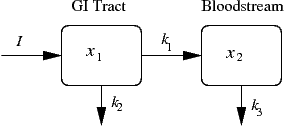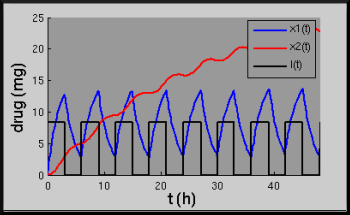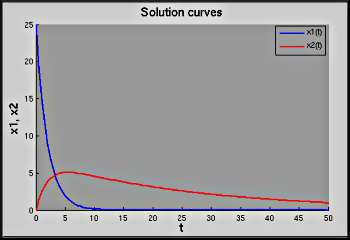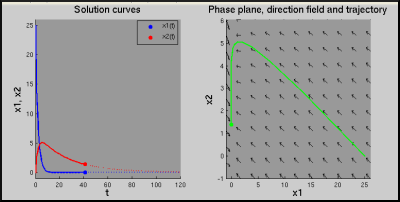Model Description
We consider a simple model for how a drug passes through a patient's
body, in which the input drug (that is, the dose that the patient takes)
enters the patient's gastrointestinal (GI) tract, and from there it may
be absorbed into the bloodstream or may pass through the GI tract and be
eliminated from the body. Similarly, the drug in the patient's
bloodstream will be filtered out by her/his kidneys. This suggests the
model illustrated below.

Here the drug input \(I\) enters the GI tract, resulting in an amount
\(x_1(t)\) of the drug being present there. In any time interval
some fraction of that (\(k_1\)) passes on to the bloodstream, while some
fraction (\(k_2\)) is eliminated from the body. We call the amount of
the drug in the bloodstream \(x_2(t)\). Similarly in the bloodstream we
expect some fraction (\(k_3\)) to be filtered out by the kidneys. We
expect that the amount of the drug in the bloodstream will be
significant for the drug's effectiveness.
ODE Model
Assuming that all transfers between and out of the compartments indicated above are proportional to the amount of the drug present there, we obtain the simple linear system \[ \begin{aligned} x_1'(t) &= I - (k_1 + k_2)\, x_1(t)\\ x_2'(t) &= k_1\, x_1(t) - k_3\, x_2(t). \end{aligned} \]
We model our drug on Promethazine, an antihistamine. Under some circumstances the absorption of this drug is 88%, and after metabolism 25% is available in the patient's system[1], [2]. Its half-life in the blood is 16-19 hours[2]. A common dosage is 25 mg[3], and clinical effects are seen after about 20 minutes [4]. As a side note, it is toxic at doses of 2.857mg/kg[5] (or, about 214mg for a 165lb individual). Using these values, we can obtain some estimates for the values of the parameters \(k_1\), \(k_2\) and \(k_3\): \(k_1\approx 0.128\), \(k_2\approx 0.383\), and \(k_3\approx 0.0385\)[6]. (Note that all of these parameter values are generated solely for use in this model, and are not clinically vetted in any manner.) Assuming that the dose is delivered uniformly over a time period of \(h\) hours, we can take \[ I(t) = \begin{cases} 25/h, & t \le h\\ 0 & t > h. \end{cases} \] For our purposes, let's assume that \(h = 3\).
Thus, we are considering the system \[ \begin{aligned} x_1' &= I - 0.511\,x_1\\ x_2' &= 0.182\,x_1 - 0.0385\, x_2, \end{aligned} \qquad\mbox{where}\qquad I(t) = \begin{cases} 25/3 & t\le 3\\ 0 & t > 3. \end{cases} \] Our initial conditions are \(x_1(0) = x_2(0) = 0\).
To consider the phase plane for this, we need the system to be autonomous, and so \(I(t)\) cannot depend on time. To look at the phase plane, we therefore consider an alternate model where all of the drug is introduced instantaneously, \[ \begin{aligned} x_1' &= -0.511\,x_1\\ x_2' &= 0.182\,x_1 - 0.0385\, x_2, \end{aligned} \qquad\mbox{with}\qquad x_1(0) = 25 \mbox{ and } x_2(0) = 0. \]
Our goal with these demonstrations is to look at the solution to this system, with some variations, and to think about what a phase plane and direction field look like for a (\(2\times2\)) system of differential equations like this.
Matlab Demos
Our demos here show several views of the solution to this system.
- Drug_Model.m:
A demonstration that graphs the solution to the system.
Configuration parameters allow the system parameters to be set,
allow the input \(I(t)\) to be a single dose or a repeated one, and
determine if the input and output are graphed on the same axes or
not.
[show
figure]

- Drug_Model_Phase_Plane_Simple.m:
A (sort of) simple demonstration. Shows the solution and, possibly,
phase plane for the system with initial conditions \(x_1(0) = I_0\),
\(x_2(0) = 0\) and \(I(t) = 0\). In the configuration section of
the demonstration file there are three parameters to determine the
behavior of the demonstration:
show_phase_planedetermines if we show only the solution to the model, or the solution and the graph of the phase plane;use_two_windowsdetermines if the graph of the phase plane (when shown) appears in a separate window or in the same window as the solution, in a second graph next to it; andinclude_pausesdetermines if there are pauses between the different graphical elements being presented. Note: also requires the file arrow.m (downloads as a zip file with the Matlab file and license). [show figure] (only solution);[show figure] (solution and phase plane)

- Phase_Plane.m:
An examination of the phase plane for this and an alternate system.
The solution curves \(x_1(t)\) and \(x_2(t)\) are shown with the
phase plane and direction field. A trace of the curves is shown,
with dots at the initial conditions; after pressing any key, the
solution is animated in the solution window and phase plane. Two
systems are considered, the drug system above (with non-zero initial
conditions and \(I(t) = 0\)), and an oscillatory system. Which is
shown is determined by a configuration variable
use_alt_solutionin the file. The demonstration can also graph the solution curves and trajectories either in one window, side-by-side, or in two windows, as determined by theuse_two_windowsconfiguration variable. [show figure]
Looking at the Model
Some questions that may be worth considering:
- When the input function is a repeated dose, will the amount of the drug in the bloodstream, \(x_2\), level off? At what value would this occur (this is most easily considered for a continuously input drug with no breaks in its administration)?
- How is the phase plane related to the phase diagrams we considered for first-order autonomous equations? How is time represented in the graph of the trajectory in the phase plane?
References
- Strenkoski-Nix LC, Ermer J, DeCleene S, Cevallos W, Mayer PR (August 2000). "Pharmacokinetics of promethazine hydrochloride after administration of rectal suppositories and oral syrup to healthy subjects". American Journal of Health-system Pharmacy: AJHP : Official Journal of the American Society of Health-System Pharmacists. 57(16): 1499-505. [on-line]
- David Wishart, Departments of Computing Science & Biological Sciences, University of Alberta. DrugBank: Promethazine (DB01069). Retrieved on: 12 Oct, 2012.
- NIH: PubChem. <http://pubchem.ncbi.nlm.nih.gov/summary/summary.cgi?cid=4927>. Retrieved on: 12 Oct, 2012.
- Drugs@FDA: FDA Approved Products Search for Promethazine. Effect time obtained for the (discontinued) drug Phenergan. Retrieved on: 12 Oct, 2012
- NIH: ChemlDplus Advanced. Search for Promethazine. Retrieved on: 12 Oct, 2012.
- Assume that \(x_1(0) = I_0\) and \(I(t)=0\), so that \(x_1(t) = I_0 e^{-(k_1+k_2)t}\); then, assuming that \(0.25 I_0\) is eventually seen in the bloodstream, we have \(\int_0^\infty\,k_1 x_1\,dt = \frac{k_1}{k_1+k_2} = 0.25 I_0\), so that \(k_2 = 3k_1\). Then, if we guess that clinical effects are seen with the delivery of 10% of a dose to the bloodstream, we have (\(t\) in hours) \(\int_0^{1/3}\, k_1 x_1\,dt = 0.1 I_0\), so that \(k_1 \approx 0.128\) and \(k_2 = 3k_1 \approx 0.383\). With a half-life in the bloodstream of 18 hours, \(k_3 = \ln(2)/18 \approx 0.0385\).
